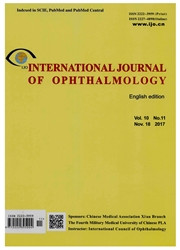

 中文摘要:
中文摘要:
AIMTo 调查在氧化应力和在网膜的颜料表明小径的表皮的生长因素受体(EGFR )/AKT 之间的串音上皮(RPE ) cells.METHODSHuman RPE 细胞线(ARPE-19 细胞) 与表皮的生长因素(EGF ) 和氢过氧化物的不同剂量被对待(H 2 O 2) 。房间生存能力被甲基 thiazolyl tetrazolium 试金决定。房间增长被 bromodeoxyuridine (BrdU ) 检验加入试金。发信号的 EGFR/AKT 被西方的污点检测。EGFR 本地化被 immunofluorescence 也检测。另外,发信号的 EGFR/AKT 被干涉在之上由 EGFR 禁止者(erlotinib ) , PI3K 禁止者(A66 ) 和 AKT 禁止者(MK-2206 ) 分别地。H 2 O 2-induced 氧化应力被抗氧化剂 N-acetylcysteine (NAC ).RESULTSEGF 处理堵住通过导致 EGFR 和 AKT 的 phosphorylation 的增加的 ARPE-19 房间生存能力和增长。H 2 O 2 禁止了 ARPE-19 房间生存能力和增长并且也由影响发信号的 EGFR/AKT 压制了 RPE 房间生存能力和增长的刺激 EGF 的增加小径。EGFR 禁止者 erlotinib 堵住了 EGFR 和 AKT 的导致 EGF 的 phosphorylation,当 A66 和 MK-2206 仅仅堵住了 AKT 的导致 EGF 的 phosphorylation 时。EGFR 的导致 EGF 的 phosphorylation 和 endocytosis 被 H 2 O 2 处理。另外,抗氧化剂 NAC 稀释了 H 2 通过减轻 EGFR 的减小的 ARPE-19 房间生存能力的 O 2-induced 抑制,和 phosphorylated 和全部的 AKT proteins.CONCLUSIONOxidative 应力通过防碍 EGFR/AKT 发信号影响 RPE 房间生存能力和增长小径。表明小径的 EGFR/AKT 可以是在氧化导致压力的 RPE 房间机能障碍的一个重要目标。
 英文摘要:
英文摘要:
AIM:To investigate the cross-talk between oxidative stress and the epidermal growth factor receptor(EGFR)/AKT signaling pathway in retinal pigment epithelial( RPE) cells.METHODS:Human RPE cell lines(ARPE-19 cell) were treated with different doses of epidermal growth factor(EGF) and hydrogen peroxide(H2O2).Cell viability was determined by a methyl thiazolyl tetrazolium assay.Cell proliferation was examined by a bromodeoxyuridine(Brd U) incorporation assay.EGFR/AKT signaling was detected by Western blot.EGFR localization was also detected by immunofluorescence.In addition,EGFR/AKT signaling was intervened upon by EGFR inhibitor(erlotinib),PI3 K inhibitor(A66) and AKT inhibitor(MK-2206),respectively.H2O2-induced oxidative stress was blocked by antioxidant N-acetylcysteine(NAC).RESULTS:EGF treatment increased ARPE-19 cell viabili ty and proliferation through inducing phosphorylation of EGFR and AKT.H2O2 inhibited ARPE-19 cell viability and proliferation and also suppressed EGF-stimulated increase of RPE cell viability and proliferation by affecting the EGFR/AKT signaling pathway.EGFR inhibitor erlotinib blocked EGF-induced phosphorylation of EGFR and AKT,while A66 and MK-2206 only blocked EGF-induced phosphorylation of AKT.EGF-induced phosphorylation andendocytosis of EGFR were also affected by H2O2 treatment.In addition,antioxidant NAC attenuated H2O2-induced inhibition of ARPE-19 cell viability through all eviating reduction of EGFR,and phosphorylated and total AKT proteins.CONCLUSION:Oxidative stress affects RPE cell viability and proliferation through interfering with the EGFR/AKT signaling pathway.The EGFR/AKT signaling pathway may be an important target in oxidative stress-induced RPE cell dysfunction.
 同期刊论文项目
同期刊论文项目
 同项目期刊论文
同项目期刊论文
 期刊信息
期刊信息
